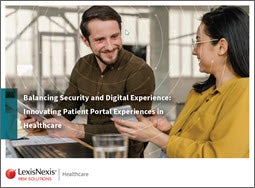Balancing Security and Patient Digital Experience

Striking the Balance: Digital Experience and Security in Healthcare
The digitization of healthcare is rapidly evolving. The integration of digital technologies offers promising benefits, but the balance between a positive digital experience and robust security measures is crucial. Provider organizations can realize many benefits from a positive digital experience for patients. And there are costs if you don’t invest properly in both digital experience and security.
Digital Experience in Healthcare: A Catalyst for Patient Engagement and Improved Health Outcomes
A positive digital experience supports patient engagement, improved health outcomes and efficient care delivery. User-friendly digital interfaces have a positive impact on patient engagement and adherence1. Accessible digital tools empower patients to actively participate in their healthcare by making it easy to access medical information, appointment scheduling and telemedicine consultations.
Research suggests a strong correlation between digital health tools and improved health outcomes1. The ease of accessing health information allows patients to stay informed about their conditions, fostering a sense of empowerment that contributes to better self-management and adherence to medical recommendations.
Digital platforms streamline healthcare processes, enabling more efficient care delivery2. From electronic health records (EHRs) to telehealth solutions, digital tools enhance communication between healthcare providers and patients, reducing administrative burdens and facilitating prompt interventions.
Security in Digital Healthcare
The importance of cybersecurity in healthcare can’t be overstated. Robust measures are necessary to safeguard electronic health records from unauthorized access and potential breaches3. A comprehensive review in the Journal of the American Medical Informatics Association emphasizes the critical role of cybersecurity in protecting patient-controlled personal health records4.
Security measures ensure the confidentiality of patient information, a cornerstone of trust in healthcare systems3. Patients must feel confident that their sensitive health data is protected from unauthorized access, identity theft and misuse.
Cybersecurity is integral to preserving trust in digital healthcare systems. Patients and healthcare providers must have confidence in the security measures implemented to protect sensitive information4. A breach not only jeopardizes patient data but also erodes trust, potentially hindering the adoption of digital health solutions.
Balancing Act: Optimizing Digital Experience While Prioritizing Security
Striking the right balance between digital experience and security involves implementing user-centric design principles5. Patient portals should be intuitive, with a focus on providing a near-frictionless user experience. Studies have shown a positive correlation between user-friendly interfaces and increased patient engagement1.
With today’s technology, you can strike that balance. New solutions can help you deliver a near-frictionless digital experience and get the security you need. And you can define risk levels for different types of digital interactions.
Why You Need to Invest in Digital Experience and Security
Neglecting investment in a secure digital infrastructure can result in compromised patient trust4. A breach of sensitive health information erodes the confidence patients have in digital healthcare systems, hindering their willingness to adopt and engage with these technologies.
The wrong balance of risk and investment in robust cybersecurity measures exposes healthcare systems to increased vulnerability to cyber threats. This not only puts patient data at risk but also opens avenues for malicious activities such as identity theft and ransomware attacks.
The absence of an optimized digital experience can lead to inefficient healthcare delivery2. Cumbersome digital interfaces, lack of interoperability and inadequate user engagement may result in delays, miscommunication and suboptimal patient care, and suboptimal patient satisfaction.
As you navigate the evolving landscape of digital healthcare, finding the balance between a positive digital experience and robust security measures is critical. The benefits of an enhanced digital experience, including improved patient engagement and outcomes, must be coupled with a steadfast commitment to cybersecurity. Neglecting investment in a secure and user-friendly digital infrastructure can have profound consequences, from compromised patient trust to increased vulnerability to cyber threats. The path forward involves a holistic approach, incorporating user-centric design and standardized security measures to foster a resilient and balanced digital healthcare ecosystem.
Footnotes:
- Becker, S., Miron-Shatz, T., Schumacher, N., & Krocza, J. (2014). mHealth 2.0: Experiences, Possibilities, and Perspectives. JMIR mHealth and uHealth, 2(2), e24.
- Buntin, M. B., Burke, M. F., Hoaglin, M. C., & Blumenthal, D. (2011). The benefits of health information technology: a review of the recent literature shows predominantly positive results. Health Affairs, 30(3), 464–471.
- Kierkegaard, P. (2017). Cybersecurity in Healthcare: A Narrative Review of Trends, Threats, and Ways Forward. Journal of Medical Internet Research, 19(9), e310.
- McGraw, D., & Dempsey, J. X. (2009). "X-Box" and the Trusted EHR: Designing for Privacy and Confidentiality in Patient-Controlled Personal Health Records. Journal of the American Medical Informatics Association, 16(2), 227–233.
- Dimitropoulos, L., Patel, V., & Scheffler, S. A. (2011). Positron emission tomography in the 21st century. Seminars in Nuclear Medicine, 41(3), 210–222.
Access the e-Book Here

